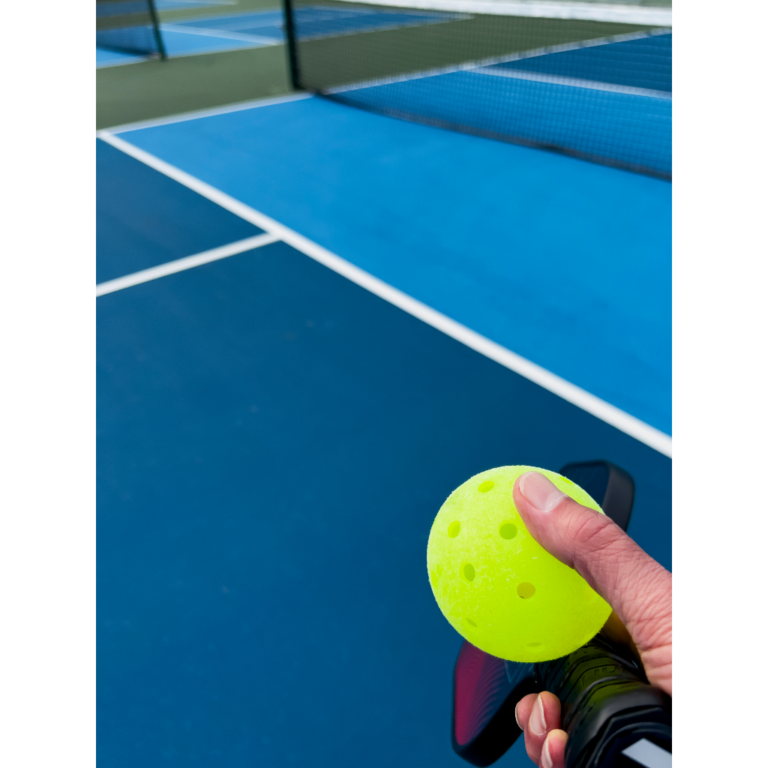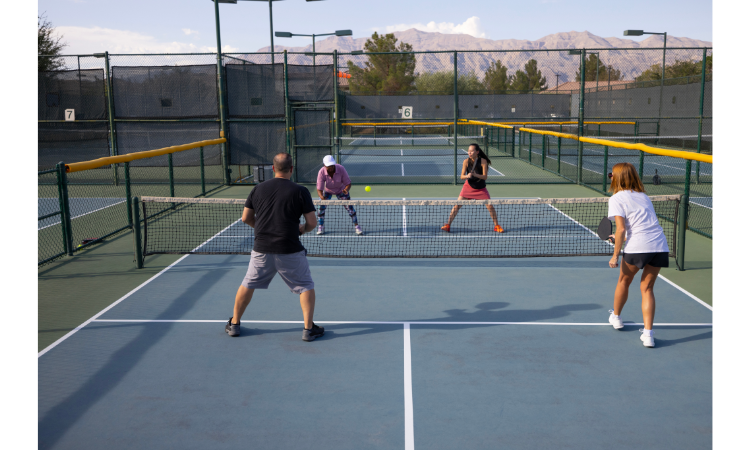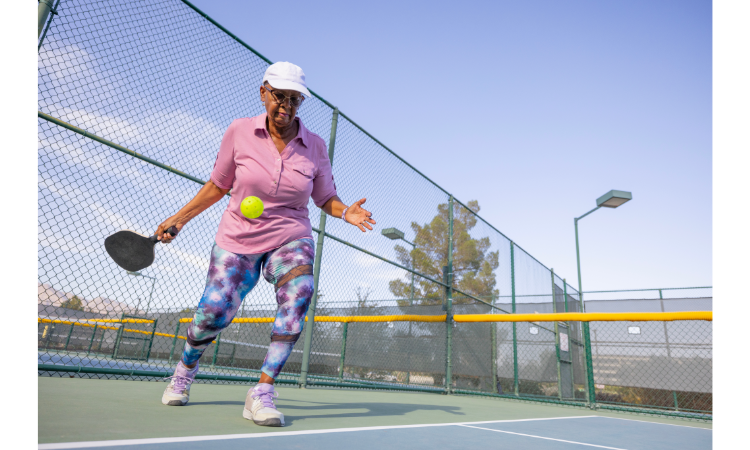Whether you’re new to the game or need a refresher, it’s important to know what a fault is in pickleball and know the types of faults in pickleball. Why? Because you don’t want to get penalized or lose a point based on a technicality.
Think about it. You go in with a solid strategy, and it’s working. You’ve managed to force your opponent into hitting a high ball, and you’re preparing to swing big. But right as you hit the ball for a clear winner, the referee yells, “Foot fault!” and you lose the rally.
Doesn’t sound like a situation you would want to have happen to you, right? I mean, you might even be wondering what is a foot fault in pickleball. Well, keep reading to learn how you can avoid this pickleball fault and more.
What is a Fault in Pickleball and Why is it Important to Avoid it?
The definition of a fault in pickleball is any action a player makes that requires the rally to stop because of a rule violation. The pickleball rules are set in place for reasons of safety and fair play.
If a player violates any of the official pickleball rules, a referee on the court can immediately stop the play and determine a replay, or call an immediate fault. When that happens, that player and teammate (if it’s during a doubles game) lose the rally.
It’s important to understand what is considered a fault in pickleball so you can avoid it at all costs. Now, mistakes do happen. In fact, even the pros get called out on rule violations from time to time. So, if a referee does call out a fault during your game that makes you lose the rally, don’t fret. Take a deep breath, regroup, and focus on a strategy for the next point.
What is Considered a Fault in Pickleball?
There are many types of rule violations that result in a fault. Some obvious ones are typically made as a forced or unforced error, while others are more nuanced. Let’s first address the more obvious faults before we dive a bit deeper into the more complex ones.
General Pickleball Faults to Remember During Gameplay
These pickleball faults are found in the 2023 USA Pickleball Official Rulebook. If any of the following happens to a player, he/she will lose the rally and continue to the next point. A pickleball fault occurs when:
- A player hits the ball under the net, between the net, or the net post.
- The ball hits the net before it crosses over to the other side of the net.
- A player hits the ball out of bounds on the opponent’s side of the court.
- A player hits the ball and the ball lands on their side of the court.
- A player stops a live ball before the ball is considered “dead”.
- A player hits the ball before it crosses the plane of the net and onto their side of the court.
- A player fails to hit the ball before it bounces twice on their side of the court.
- This rule does not apply to wheelchair pickleball.
Pickleball Faults That Violate Nuanced Pickleball Rules
If you’re new to pickleball, there are some pickleball-specific rules that you need to understand in order to grasp why violating them results in a pickleball fault.
1. 2 Bounce Rule Violation
The 2 bounce rule in pickleball states that a player cannot hit the ball out of the air (volley) until the ball has bounced from the serve AND the return. For example, if Player A serves the ball to Player B, and Player B hit’s the ball before it bounces, this results in a pickleball fault.
Similarly, if Player B returns the serve to Player A, and Player A hits the ball before it bounces on their side, this is also considered a pickleball fault.
2. Non-Volley Zone Violations
There are specific rules when playing in the non-volley zone, aka the kitchen. If any of the following kitchen rules are broken, it’s considered a pickleball fault. Here are the most common ones.
- If a player volleys the ball while in the kitchen or on the kitchen line, the referee will call a foot fault, resulting in a loss of the rally.
- If a player pushes off the kitchen line to hit an overhead or any type of ball out of the air, the referee will call a foot fault.
- If a player hits an ernie (jumping the kitchen line to hit a volley and lands on the side of the kitchen) and lands on the kitchen line or inside the kitchen, the referee will call a foot fault.
I highly recommend reading more in-depth Non-Volley Zone rules and strategies on our site.
3. Serve, Serve Sequence, and Scoring Rule Violations
Some of the most common pickleball faults occur when a player is out of position during a service motion, when the wrong score is called, and even violating the serving rules. Here are some pickleball serve faults to avoid.
- If a player serves the ball and makes contact above the waist, or if the paddle is above the wrist on contact, the referee can call a pickleball fault.
- If a player serves while standing on the baseline, or any part of their body crosses the centerline, a referee will deem this a pickleball fault.
- If a player serves the ball before the score is called, the referee may deem this a pickleball fault.
- If a player is on the wrong side of the court after the serve is made, the player on the wrong side committed a pickleball fault.
Rare Pickleball Faults That Every Player Should be Aware of
There are some scenarios in pickleball that leave players wondering if it’s a replay or an actual pickleball fault. Here are some rare pickleball faults that not all players may know about, but should definitely be aware of.
1. If the Ball Hits a Player Above the Wrist
If a player gets hit with a ball during a rally, the ball is considered dead and the person who was hit with the ball loses the rally. However, if a ball hits a player below the wrist during a legal play and it travels over the net, the ball is considered live still.
This scenario happened recently at a Professional Pickleball Association (PPA) tournament in a Men’s Doubles Pro match. Matt Wright, top 5 pickleball player, was hit during a point, but the ball still traveled over the net and in bounds.
The referee automatically called a pickleball fault because he thought the ball hit him on the arm, which would have resulted in a loss of the rally. However, Wright claimed it hit him below the wrist, making it a legal play.
NOTE: In certain professional tournaments, pros can contest a referee call if they have a timeout available. If a player or team has no more timeouts available, they cannot contest a referee.
Matt contested the call and the video replay confirmed that the ball did, in fact, hit him below the wrist, making the play legal. Because this was a referee error, they had to replay the point.
2. If a Player Stops a Rally and Calls a Hindrance but the Referee Deems the Call Invalid
If you have a referee on the court, it’s best to continue a rally UNTIL the referee stops the point. However, if a ball comes onto the court and it’s distracting or could cause serious injury, please stop the point for safety reasons. In this case, the referee will deem it valid. If not, I recommend speaking to the tournament director if you feel strongly about the situation.
3. If a Player, Their Apparel, Or Paddle Hits the Net System While the Ball is Still Live
I’ve seen multiple scenarios where a player hits a ball that is close to the net, and in the process touches the net. This can be with their paddle, or they themselves lose their balance and hit the net by accident. This is considered a pickleball fault and results in the loss of the rally.
Knowing the Rules of the Game
It helps to know the basic rules when trying to understand what is considered a fault in pickleball and how to avoid it. Don’t let the possibility of committing a fault stop you from playing and enjoying pickleball. No one is perfect. Sometimes, you will lose points and you will lose games. It’s how you respond to the fault that separates a great player from an average player.




































